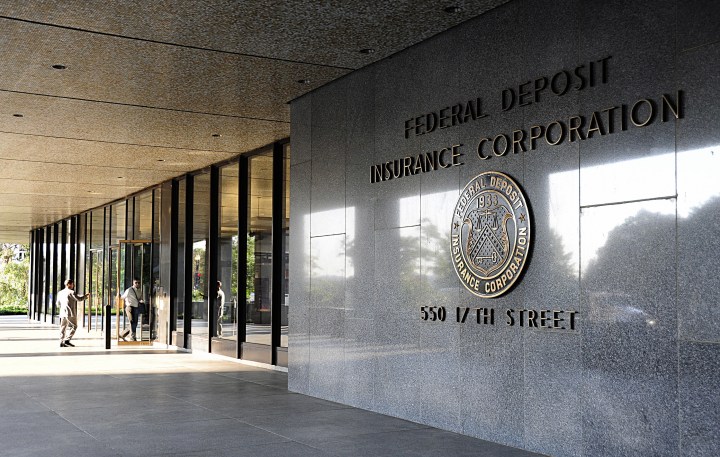
You can protect more than $250,000 at a bank. But beware the “moral hazard.”
Share Now on:
You can protect more than $250,000 at a bank. But beware the “moral hazard.”

This is just one of the stories from our “I’ve Always Wondered” series, where we tackle all of your questions about the world of business, no matter how big or small. Ever wondered if recycling is worth it? Or how store brands stack up against name brands? Check out more from the series here.
Listener Victoria Davis asks:
The recent failure of Silicon Valley Bank made me wonder: The FDIC covers deposits up to $250,000. Can a depositor buy additional insurance (from FDIC or elsewhere) to cover money over the $250,000 limit?
Silicon Valley Bank collapsed last week after a combination of factors led to a run on the Santa Clara, California-based institution and resulted in the country’s second-largest bank failure. A few days later, Signature Bank in New York City also failed.
The Treasury, Federal Reserve and Federal Deposit Insurance Corp. announced Sunday that customers would be able to access all of their money, including amounts over the FDIC’s $250,000 limit.
Deposits at FDIC-insured banks are guaranteed in case of failures like those at SVB and Signature. But what if you have more than $250,000 and the government didn’t just make an exception to the rule? There are several ways individuals and companies with larger deposits can bypass this limit.
How depositors are able to surpass the $250,000 limit
First, you can qualify for coverage of more than $250,000 if you have funds in different ownership categories at an FDIC-insured bank, according to the agency’s website.
For example, you could have an account in your name alone, a joint account in your name and your spouse’s name, or an account set up for retirement savings, explained George Pennacchi, a finance professor at the University of Illinois Urbana-Champaign.
“These are all different types of ownership accounts that, even though they’re in the same bank, are each eligible for the $250,000 limit,” Pennacchi said. “So that, for many people, can be one way of sticking with one bank and still getting quite a bit of deposit insurance coverage.”
Pennacchi said you can also set up accounts at different FDIC-insured banks that would cover your deposits up to the $250,000 limit.
On top of these options, there are services that will do the work of spreading your money across different banks. The IntraFi Network Deposits program enables you to deposit your money at one member bank, which will then split up your money into amounts below the $250,000 threshold, then transfer it to other banks in the network.
One of its services, the Insured Cash Sweep, will divide your funds into money market accounts that pay interest but limit withdrawals, or demand deposit accounts that allow withdrawals at any time.
IntraFi also has a service that places your money into certificates of deposit, accounts with a specified term (like six months or five years) that pay you the principal plus interest accrued by the end of the term.
Pennacchi noted that these services are safe for depositors to use.
And if you don’t need your money right away, you can invest in U.S. Treasury bonds, said Patricia McCoy, a law professor at Boston College. Treasurys are backed by the government and won’t result in any principal losses if you hold those bonds to maturity.
“I think the real challenge is for businesses and nonprofits,” McCoy said.
To make payroll every two weeks or every month, medium- and large-sized companies will need “more than $250,000 on tap at one bank,” she said. “And it’s really inconvenient to spread that money around if you need to be using it for payroll.”
Why not raise the FDIC limit?
Some lawmakers have criticized the FDIC’s deposit limit and called for a higher cap. McCoy said the current $250,000 limit should cover deposits from most households, while higher-income households are able to spread their cash easily among different banks.
But some experts think the limit shouldn’t be higher and that there shouldn’t be ways to bypass the current limit.
Counterintuitively, deposit insurance might create what McCoy and Pennacchi call a “moral hazard,” where insurance protection can actually encourage risk-taking because banks know they won’t face consequences.
McCoy has previously written that banks might, for example, increase their leverage or invest in riskier assets. And Pennacchi said this may give people less incentive to find a bank that is being “operated relatively safely.”
Even President Franklin D. Roosevelt, who signed the banking law that created the FDIC, was opposed to the concept.
Roosevelt and some bankers were against an insurance program out of concern that it would reward “inept banking operations,” wrote Christine M. Bradley in a paper on the history of insurance coverage for the FDIC Banking Review.
If your goal is to penalize banks for taking excessive risks, then you can’t insure all of the banks’ deposits, Pennacchi said.
The limit we have now is “a relatively high level of coverage,” he said. “With all the loopholes, you can get almost unlimited coverage.”
There’s a lot happening in the world. Through it all, Marketplace is here for you.
You rely on Marketplace to break down the world’s events and tell you how it affects you in a fact-based, approachable way. We rely on your financial support to keep making that possible.
Your donation today powers the independent journalism that you rely on. For just $5/month, you can help sustain Marketplace so we can keep reporting on the things that matter to you.












